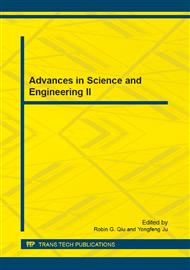[1]
WANG Haijun, ZHANG Wenting, HE Sanwei, DENG Yu. An Image Segmentation Method Based on Cellular Automata and Fuzzy C-means, Geometrics and Information Science of Wu han University, Vol. 35. No. 11, pp.1299-1291, Nov. (2010).
Google Scholar
[2]
Balafar. M.A., Ramli. Abd. Rahman, Saripan. M. Iqba, Mahmud. Rozi, Mashohor. Syamsiah, Balafar. Molod, New Multi-scale medical image segmentation based on Fuzzy C-Mean (FCM), Proceedings of the 2008 IEEE Conference on Innovative Technologies in Intelligent Systems and Industrial Applications, Malaysia, pp.66-70, July (2008).
DOI: 10.1109/citisia.2008.4607337
Google Scholar
[3]
ZHANG Chen Guang, LI Yu-Jian. Hash Graph Based Semi-supervised Learning Method and Its Application in Image Segmentation, Zidonghua Xuebao. Vol. 36, No. 11, pp.1527-1533, November. (2010).
DOI: 10.3724/sp.j.1004.2010.01527
Google Scholar
[4]
Blum. Christian, Dorigo. Marco. The Hyper-Cube Framework for Ant Colony Optimization, [J], IEEE Trans Syst Man Cybern Part B Cybern, Vol. 34, No. 2, pp.1161-1172, April (2004).
DOI: 10.1109/tsmcb.2003.821450
Google Scholar
[5]
Dorigo M. Ant Colony Optimization, [M], Tsinghua University Press, pp.64-114, (2006).
Google Scholar
[6]
HAN Fang, ZHOU Zhong-xun, SUN Yi. Reactive power optimization based on the improved dual population ant colony algorithm, [J], Journal of Northeast Dian li University, Vol. 30. No. 4, pp.48-52 Aug. (2010).
Google Scholar
[7]
BI Shuo-ben, DONG Xue-shi, MA Yan. Design and Analysis of TSP Problem Based on Genetic Algorithm and Ant Colony Algorithm, [J], Journal of Wuhan University Of Technology. Vol. 32 No. 16. pp.89-92, Aug. (2010).
Google Scholar
[8]
Lizhong Jin, Jie Jia, Guiran Chang, Xingwei Wang. Restoration of coverage blind spots in wireless sensor networks based on ant colony algorithm, World Summit on Genetic and Evolutionary Computation. pp.847-850, June, (2009).
DOI: 10.1145/1543834.1543958
Google Scholar
[9]
Wenjun Yin, Hairong Lv, Feng Jin, Jin Dong, Liying. Shangguan. Distribution maintenance scheduling using ant colony algorithm (ACA), IEEE/INFORMS International Conference on Service Operations, Logistics and Informatics, pp.624-628, July, (2009).
DOI: 10.1109/soli.2009.5204009
Google Scholar
[10]
Zhang Huaizhu, Xiang Changbo, Song Jianzhong, et al. Application of improved adaptive genetic algorithm to image segmentation in real-time, [J], Optics and Precision Engineering, Vol. 16, No. 2, pp.333-337, February (2008).
Google Scholar


